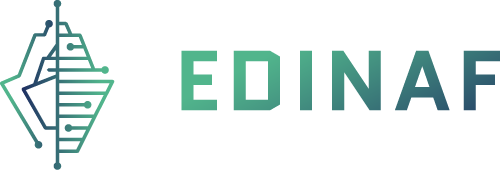Work Packages
EDINAF will provide enhanced capabilities and faster vessels reaction through the specification of a digital ship and the development of a European digital ship reference architecture, through a work structured as follows:

WP1
Project Management & Coordination & Exploitation — Led by Navantia
Under this work package, the core objective is to organize the activities towards the completion of the project, its goals and objectives, as well as to ensure a smooth cooperation between the partners. This includes carrying out EDINAF’s general administration, developing management strategies, performing risk and quality management activities, qualifying ethics principles through the completion of EDINAF’s deliverables, notably considering the preservation of the environment. Finally, communication and dissemination activities are essential activities of this work package.

WP2
Collecting, Understanding Needs and Defining Requirements — Led by Fincantieri
The core objective of this work package is to identify common requirements for a ship digital architecture. To do so, the partners agreed to build a common language of reference to facilitate the networking dialogue with the plurality of stakeholders involved in the project. The next step is to determine the best interview methodology and techniques, based on inputs after collecting the stakeholders’ and navies’ needs and expectations. This work will be enriched by the outcomes of elicitation collected from the MoDs, the shipbuilding industry, and suppliers who are interested in the project.
All the collected data will be used to identify the requirements meant for the digital ship and ship digital architecture, which will be characterized in terms of capabilities and tasks. This work will also serve as the basis for the development carried out under WP3 – Digital Ship Reference Architecture.

WP3
Digital Ship Reference Architecture — Led by Naval Group
This work package aims on the one hand to develop an IT model that meets the Digital Ship’s needs in terms of resource sharing, evolution, maintainability and ease of use. On the other, to define a Digital Ship Reference Architecture framework for the data centric IT infrastructure effective for describing the roles, sub-roles, cross-cutting aspects, as well as the functional components of the future Digital warship IT infrastructure. This aims to:
- have a list of the stakeholders and fundamental characteristics of the data centric IT infrastructure systems;
- to specify its basic activities and functional components and describe their relationship to each other and to the environment;
- and finally, to identify and list the principles guiding the design and evolution of the Digital Ship Reference Architecture.

WP4
Digital Platform — Led by Navantia
The ambition is this work package is to define the specifications of the digital platform, in accordance with the reference architecture, suitable to support user services and microservices and integrating systems on different levels of digitalisation (legacy, intermediate and native). The intention is to establish common specifications for digital platforms, enabling scalability & interoperability.

WP5
Data — Led by tkMS
With the general objective to reach an increased intelligence and awareness, this work package foresees the standardization of data needs requested by digital platform services and application use cases. Also for the development of a data management plan, comprising the control of consistency and homogeneity, ensuring the availability and accessibility of trusted and interoperable data.
Then, the objective is to reach a proof of concepts for different evaluation and fusion tasks on data, find an appropriate storage option for data (including meta data) and an appropriate availability and traceability considering security requirements and restrictions.

WP6
Connectivity — Led by Navantia
Focused on connectivity, this work package envisions studies to be carried out to:
- Explore the key disruptive technologies applied to connectivity and to the naval domain, with the objective to define opportunities, including in cross-domain aspects;
- Define and assess naval domain connectivity constraints and carry out a design-trade-off analysis;
- Explore naval onboard capabilities, including the creation of standards for naval cloud onboard, in coordination with cross-domain cloud project;
- Create standards based on a prior assessment of Digital Ship-UXV units connectivity technologies.

WP7
System Integration — Led by Fincantieri NexTech
Within this work package, the intention is to define common criteria for:
- the implementation of Use Cases in the digital platform,
- the development and integration of the involved simulation models,
- addressing the potential for extension of the system into a full set of sensors and platform systems onboard.
The developments and results of the activities and analyses carried out in this work package will enable a possible update of the requirements applicable to onboard systems.

WP8
Digital Twinning — Led by Navantia
Based on the assessment of the suitability of key technologies applied to digital twinning, the ambition under this work package is to elaborate a digital twinning methodology, which considers different levels and model hierarchy between each key technology, to determine how to interact with the operators.
These outcomes will be used to develop Reduced Order Models (ROM) specifically adapted to selected EDINAF applications, as well as a hybrid analysis and modelling techniques, dedicated to selected EDINAF applications. Finally, these results, combined with the identification of constraints related to these applications, will enable the definition of constraints and standards for developing and executing models.

WP9
Building Digital Engineering + Digital Thread Using Models — Led by Naval Group
This work package aims firstly to build the digital engineering for the Digital Warship Systems (consisting of IT infrastructures and naval Systems) in relation and in alignment with Enterprise Architecture and MBSE, with the overall objective to accelerate the modernization of warships by improving speed of delivery.
The second objective behind this work package is to build a centralized Authoritative Source of Truth, easily accessible to the involved stakeholders, which will take the form of a Proof of Concept, to emphasize the advantages of this solution to perform activities, collaborate and communicate across stakeholders.

WP10
Demonstrator — Led by Naval Group
The intention behind this work package is to implement the project design and develop a demonstrator architecture, in accordance with the Reference Architecture (developed under WP3) and the Digital Platform specifications (see WP4). The targeted Enterprise framework infrastructure will provide capabilities able to support computing, storage, and server virtualization technologies, standardized operational tasks, resilient and secure functionalities.
Also, the ambition is that the developed demonstrator forms the backbone of the Digital Warship computing infrastructure. Lastly, this demonstrator will be designed with the ability to provide self-service capabilities, to support the integration of Use Cases and to evaluate the compliance of multiple naval systems with the demonstrator.

WP11
Operational Control System (OCS) — Led by Kongsberg
Under this work package an Operational Control System (OCS) will be developed, divided into four main functional areas to cover naval operations, spanning from peace, crisis, to war (warfare, damage control, predictive and corrective maintenance strategies, mission planning and enriched external situational awareness).
This OCS aims at ensuring high value military tasks, through an increased level of automation, providing scalable decision support to the crew, ensuring operational efficiency and readiness, obtaining higher efficiency in OODA-loop and finally increasing safety with a reduced crew and decreasing the total life cost of the ship.
To achieve this, the developed OCS will be adapted to various parameters including the crew’s responsibilities, the command team and decision-making tools, and the situation (external or internal battle).

WP12
Decision Support for Autonomous UxV’s and Enhanced Situation Awareness — Led by Saab
This work package focuses on the development of decision support Use Cases in different situations, with the overall objective to enhance situational awareness and the communication with the surrounding units. It is planned that three types of Use Cases are developed:
- UxV decision support Use Cases
- CMS UxV integration and interfaces Use Cases
- GNSS independent positioning Use Case

WP13
Automated Reliability and Availability Assessment — Led by Damen
The focus of this work package is the assessment of an automated reliability and availability (R&A) for platform systems to provide real time decision support functions, to better plan and execute high value military tasks. Overall, the objectives of this work package are the following:
- Increase the level of automation and support to the ship’s crew
- Obtain higher speed in the OODA-loop
- Increase safety with a reduced crew
- Provide insights in actual and predicted system R&A
- Provide solution scenarios (considering command aim and R&A state)

WP14
Condition Management of Ship Machinery — Led by Fincantieri NexTech
The scope of this work package is to enable the Validation of Project results through the realization of Use Case on remote condition-based management (RCBM) of ship machinery at the fleet level, according to a Predictive Maintenance (PdM) that leverages the exploitation of BDAA.
To this end, it is envisaged that a Big Data Platform with the ability to handle huge amounts of data in manufacturing or production logistics databases is created, after with the PdM will be defined. In addition, a Maintenance Decision Support (MDSS) application, which further process the analysis of the PdM module will be set up, to formulate optimal maintenance strategies thus supporting maintenance decision-making.

WP15
Crew Training and Advance HMI with Agents/Assistants Use Cases — Led by Navantia
This work package aims to define ship crew training services, and the Smart Agent’s Standardization for empowered/enriched user experience. The idea behind Digital training is to supply collaborate environments where crew members will be able to live real experiences, minimizing the expenses and risks of real exercises.
Therefore, after defining the digital ship’s crex training service and standardizing the Digital Ship’s Smart Agents, the objective is to develop Minimum Value Product (MVP) smart agent applied to Chilled Water System management and applied to radar/EW management.

